VJ Day 80
13/08/2025 | Emma Garnham , Matthew Tredwen , Vince Scopes
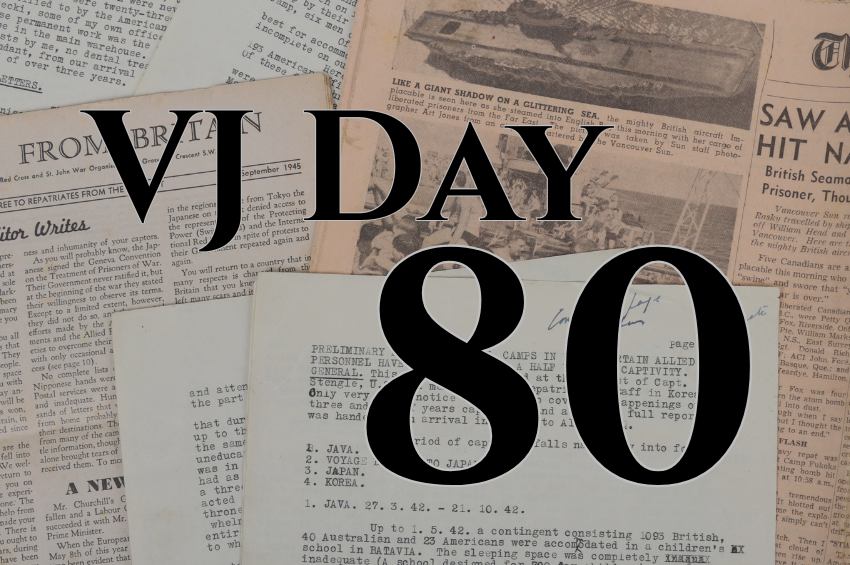
What is VJ Day?
15th August 2025 marks 80 years since the surrender of Japan to the Allies, marking the long-awaited end of World War 2. This day became known as Victory over Japan Day, or, VJ Day.
In this post we will be exploring the history of VJ Day, as illustrated by documents consigned by the family of a surviving Prisoner of War from the Japanese camps.
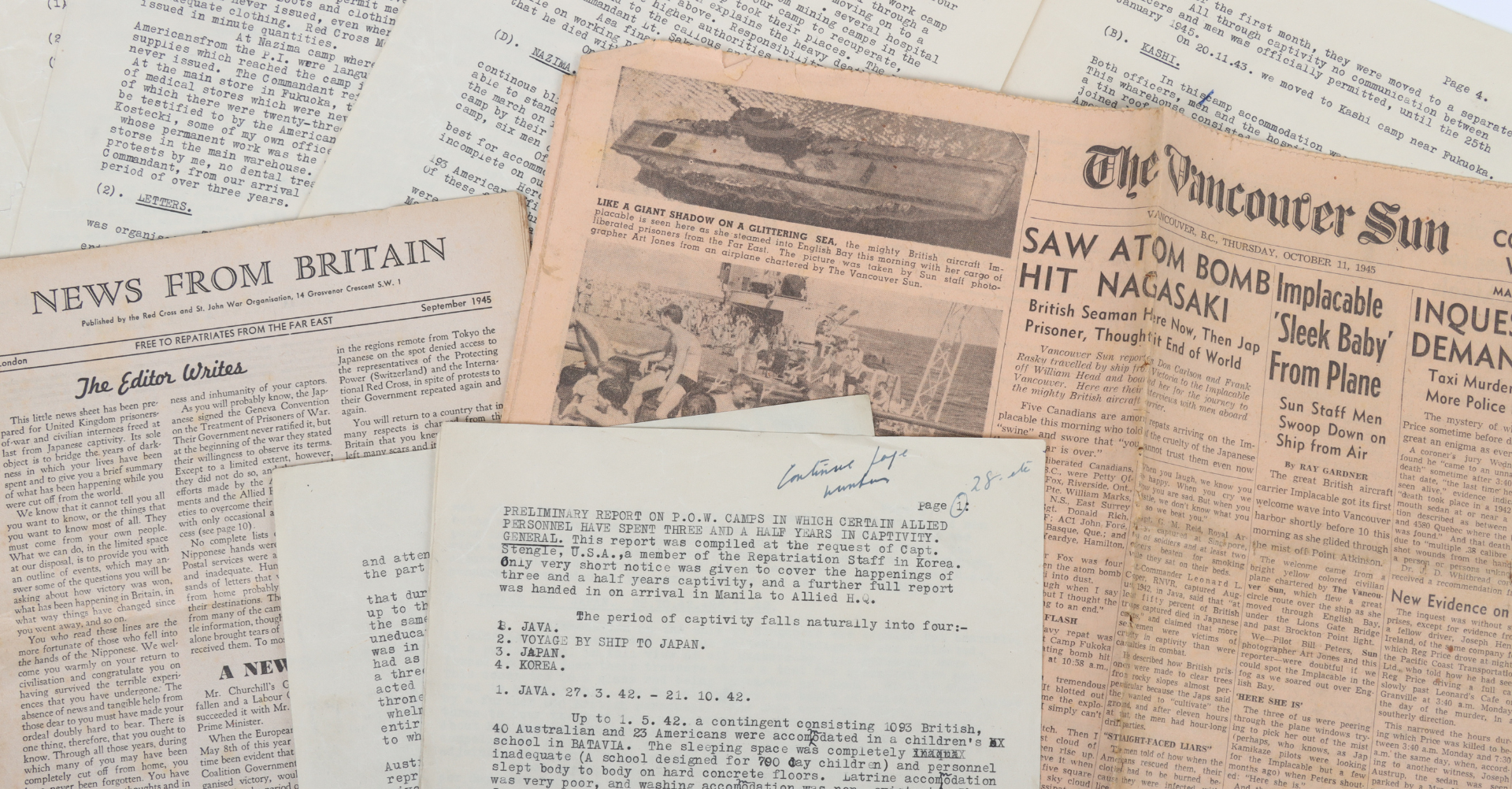
Why did VJ Day happen?
Japan’s expansionist policies of the 1930s had drawn them into conflict with China in the Second Sino-Japanese War (1937-1945). This strained the country’s resources. Eventually, the US stepped in demanding a complete abandonment of Japanese ambitions in China. Japan responded with the devastating attack on Pearl Harbour in 1941, escalating tensions between the US and Japan into all out war.
Aware of the superior resources available to the US, Japan's strategy had been to decisively destroy the United States Pacific Fleet at Pearl Harbour, and then capitalise on the victory with rapid, strategic victories over the US. Ultimately this strategy failed, but fighting dragged on until 1945.
The end of war in Europe with victory over Germany in May 1945 allowed the Allied forces to concentrate their efforts on the final end of the war. This included the USSR joining Allied forces against Japan. Facing down the combined goliaths of global powers, prospects of a Japanese victory were slim-to-none. At the Potsdam conference on 26th July 1945, the Allied forces offered Japan the chance to surrender, or else face “prompt and utter destruction”.
Japanese Prime Minister, Suzuki Kantaro, refused to respond to the ultimatum, sealing the nation’s fate and leading to one of the more bleak events in human history - the dropping of the atomic bombs.
On the 6th August the first atomic bomb was dropped on Hiroshima, razing the city to the ground and annihilating thousands of civilians instantly. Nagasaki faced the same fate 3 days later when the second bomb was dropped on the city. Across the two bombings it is estimated that over 100,000 were killed, while many thousands more were seriously injured in the firestorms which raged across each city. The aftermath of these bombings endured for years, as many more civilians succumbed to the effects of radiation poisoning.
Harrowing and devastating, the atomic bombings were also decisive. They were the final straw in the war, as Emperor Hirohito made his first radio broadcast to his subjects just six days later, to announce Japan’s surrender. The official surrender was signed on 2nd September and World War II officially came to a close.
What happened after VJ Day?
Japan reeled from the destruction of the atomic bombings and end of the war. Demobilisation, repatriation and settlement of Japanese soldiers after the war exacerbated the already dire food shortages in Japan. As the nation rebuilt under Allied occupation, a new, constitutional government was established which enshrined personal liberties, social justice and political morality.
To Allied serviceman, the surrender of Japan and final end to WWII signalled an imminent return home, although the brutal experiences suffered during the war, especially by prisoners of war, would remain with them.
Amongst the consignments at C&T we have come across a collection of paperwork relating to the end of the war and repatriation of British Prisoners of War, or POWs, from Japan. Come with us as we take a look through just 3 of these historically significant documents.
News From Britain
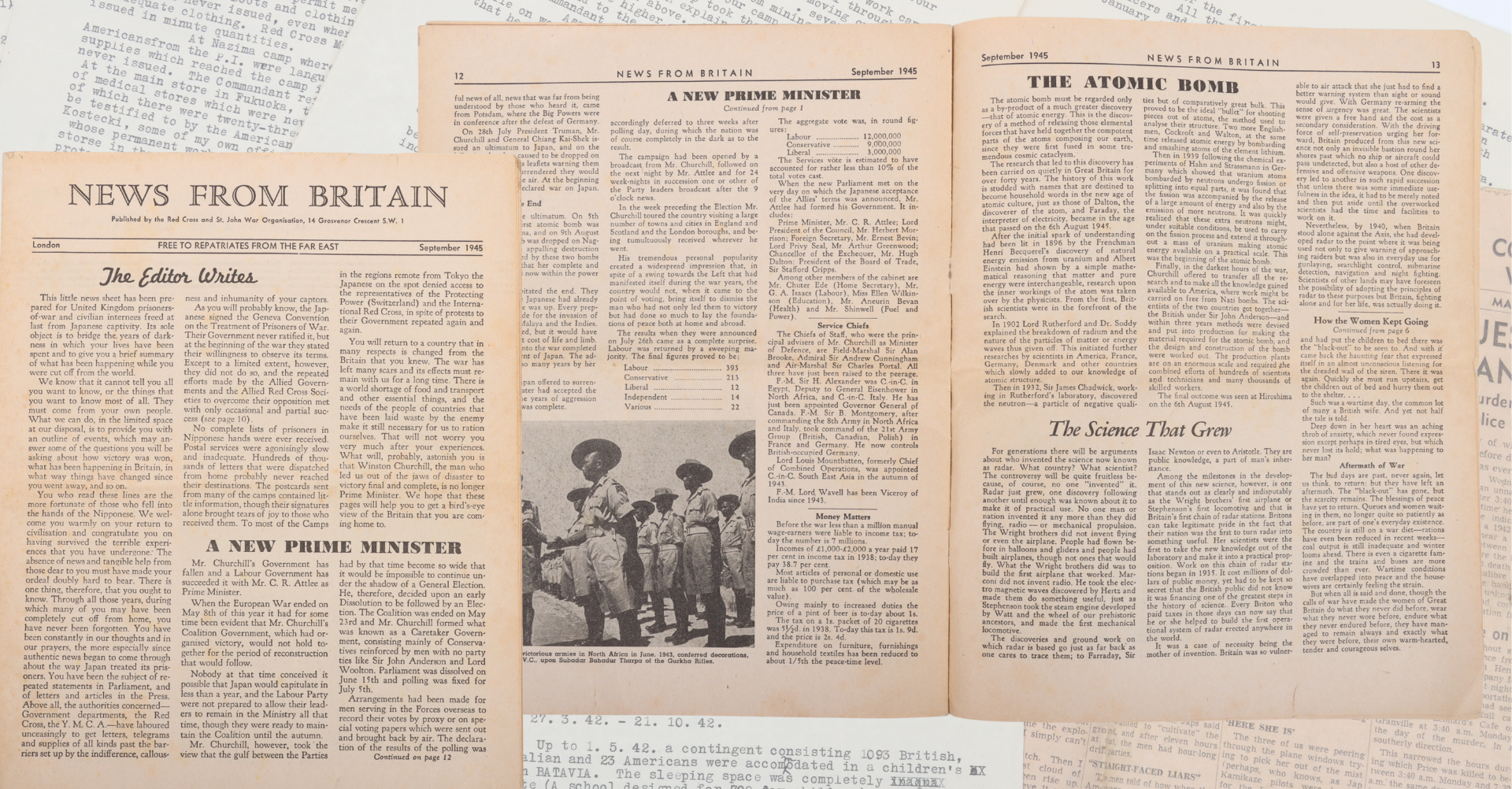
An engaging document which truly puts into perspective the alienation with which POWs must have grappled with, this news sheet produced by the Red Cross and St John War Organisation. The document aimed to outline all the major developments in politics, technology and daily life which POWs may have missed, as well as outline how the war was won and what happened to all its major players.
‘This little news sheet has been prepared for United Kingdom prisoners-of-war and civilian internees freed at last from Japanese captivity. Its sole object is to bridge years of darkness in which your lives have been spent and to give you a brief summary of what has been happening while you were cut off from the world.’
Such updates include the development of Radar (along with disputes over intellectual property to this technology); Churchill’s loss of power and replacement with Atlee as PM; life in Britain throughout the air raids; the execution of Mussolini and capture of Hitler's body; the liberation of France; changes to rationing, and so much more.
A significant impression which can be gathered from the document is of the capacity for invention and technological development which can be afforded in wartime. It specifically highlights the willingness and necessity to invest in the sciences, where ‘scientists were given a free hand and the cost as a secondary consideration’ to be able to respond to the evolving demands of war.
Besides Radar, the technological advancements listed include the use of pre-fabricated ‘Mulberry’ harbours, DDT and, of course, Penicillin. It was indeed 'a case of necessity being the mother of invention’.
'Saw Atom Bomb Hit Nagasaki'
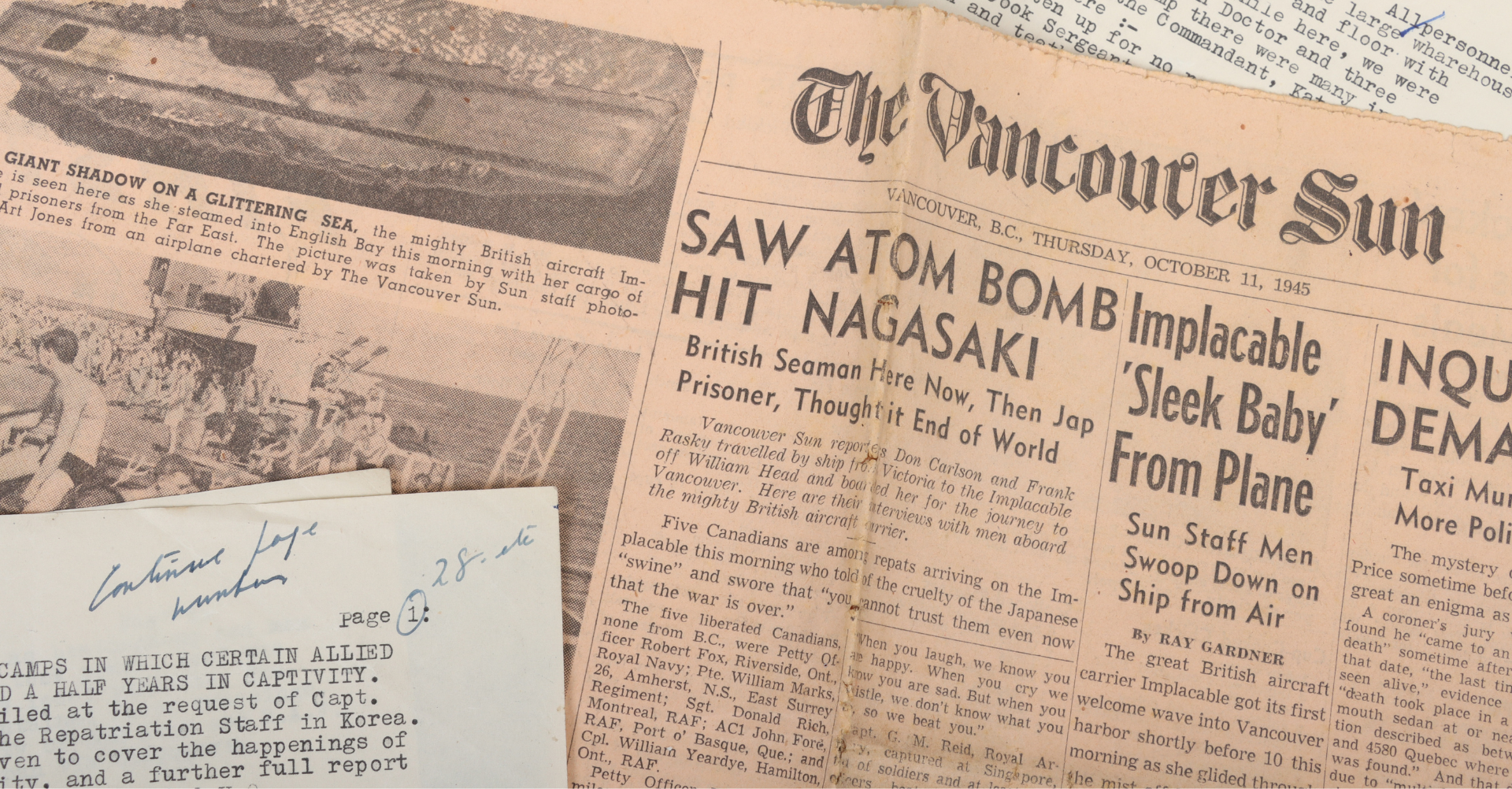
A newspaper clipping records the historically significant eyewitness account of Petty officer Fox, who was held a prisoner of war camp 4 miles outside of Nagasaki at the time the bomb was dropped.
Fox described the surreal and terrifying experience:
“There was a tremendous flash,’ he said. ‘It blotted out the sun. Then came the explosion, and, brother, I simply can’t describe that noise.” … “The few prisoners with me kept asking: ‘What can it be? What can it be?’ You can imagine our fright.”
This account, coming from an Allied serviceman, is a reminder of the far-reaching and indiscriminate destruction of the atomic bombs.
Preliminary report on P.O.W. camps…
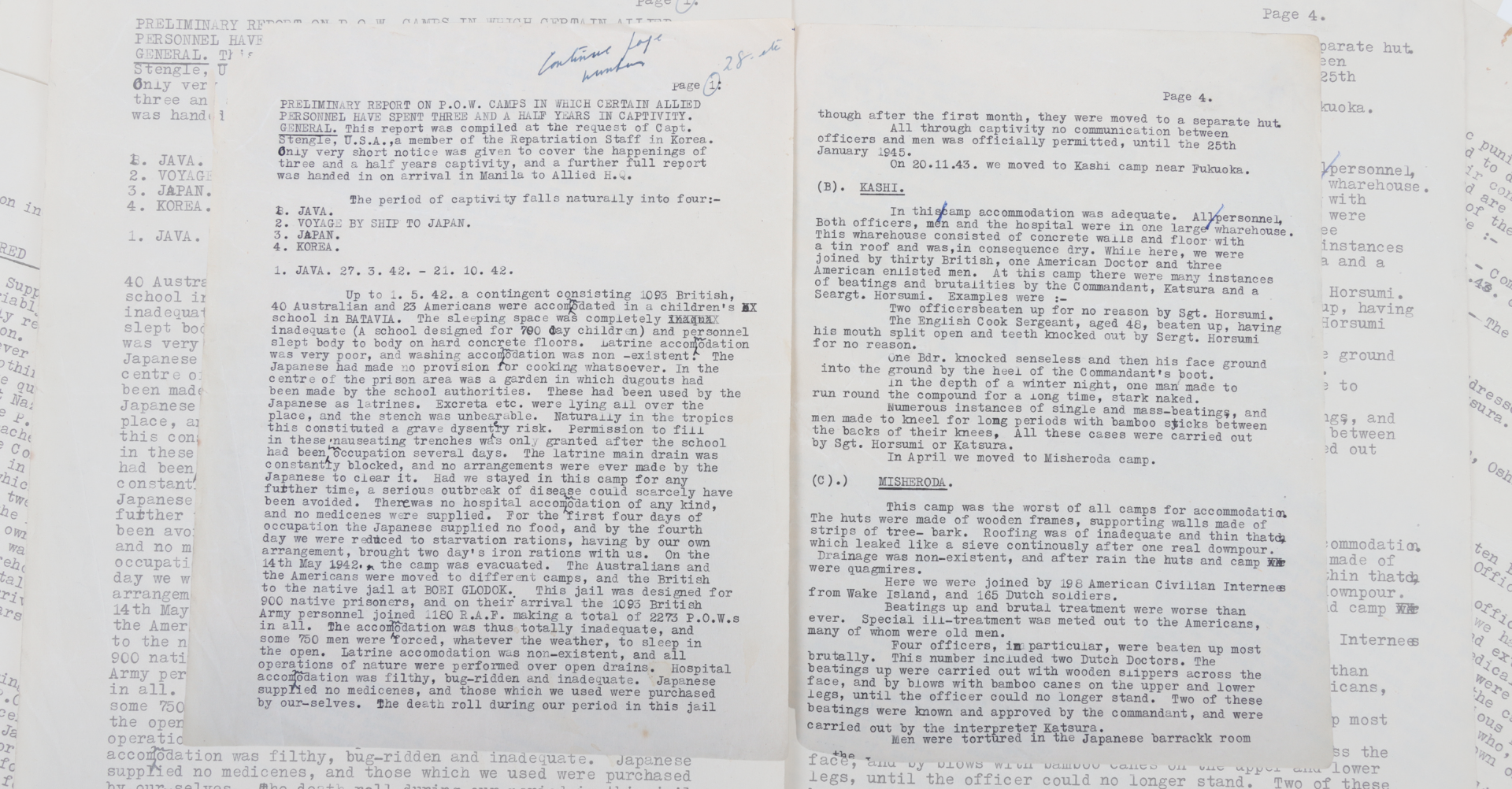
A report commissioned by US officials into the camps in which allied servicemen were inmates outlines the vicious treatment prisoners of war had endured for up to three and a half years.
Beginning with the transport of captured servicemen to Japan, the report immediately communicates the cramped, and disgusting conditions in which POWs were left to cling to survival. After reaching Japan, ‘practically every man was suffering from scurvy, pellagra and general exhaustion’. Having spent months in cramped, dirty, hot conditions, subject to regular humiliation and without sufficient food, water, or medicine, this report makes it clear why the death rates in Japanese POW camps were so high.
‘Deaths were practically all due to poor food, lack of warm clothes and totally inadequate medical supplies… and in some cases, brutal treatment on the part of the Japanese authorities.’
The specific cruelty and exploitation of power by those in command is a recurrent theme. At Misheroda camp, which is described as the worst, the report details that ‘beating up and brutal treatment were worse than ever. Special ill-treatment was meted out to the Americans, many of whom were old men.’
Over the course of the report, the death toll steadily stacked up. To compound these horrific experiences, men were refused access to Red Cross supplies and rarely received their letters from home, a small but significant detail which is stated as having been particularly devastating to the already struggling morale.
Looking back at VJ Day
VJ Day continues to hold a significant place in global memory, marking the end of World War II and the associated suffering. However, the impacts of the war were enduring, and cast their shadow well in to the twenty-first century.
The progress which has come about since the writing of these reports can offer us optimism for the capacity for change. That is not to say, however, that the lessons of the past have been resolved. Debates continue to rage on over the use of atomic weapons and nuclear resources more generally.
On the 80th anniversary of the end of WWII, we are offered the opportunity to reflect on the world we have inherited and our role in it. The way in which these sources illustrate the costs of war on all sides drives home the importance of efforts towards peace. Meanwhile, the contents - still shocking all these years later - reminds us of the importance of actively defending human rights and humane treatment of others, especially in wartime.
Learn more
Check out the links below to explore some more WWII history:
- VE Day - the 80th anniversary

